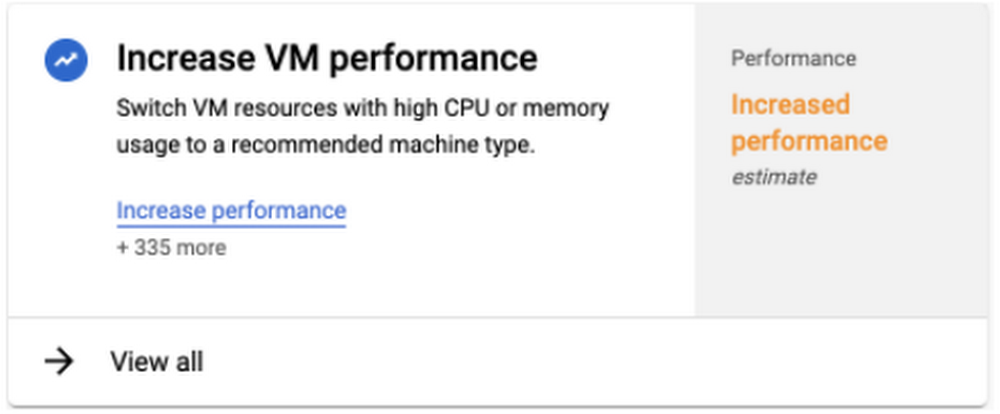Let's migrate: why lifting and shifting is simply too easy to ignore
Enterprises across all verticals are choosing Google Cloud as their preferred partner for digital transformation. Taking such a transformational approach to cloud adoption, and building modern, cloud-native services brings the largest impact to an organisation – in terms of business agility, return on investment, time to market and more. The cloud’s scale and flexibility enables an organisation to build services that just wouldn’t have been possible in an on-premises data centre. When our Professional Services teams engage with customers, we adopt a holistic approach to cloud migration, and generally examine the complete technology landscape in an organisation before embarking on the cloud journey. We recommend that you focus efforts on modernizing high-value workloads that create business-differentiating value; and our experience shows that this is likely in many cases easier than you think. This approach results either in greenfield software development, or in a “modernization factory”; we’ve described these outcomes in a previous blog post. However, this sort of transformation, or even incremental modernization of workloads to take advantage of platform-as-a-service services like Google Kubernetes Engine and Cloud SQL takes time and effort. This is an effort that may not be justified for legacy workloads. We also often encounter customers who have a strong desire to modernise their applications but can’t because of one or more of the following challenges:Scaling infrastructure on premises can be hard – but you might not have the time or resources to modernise the application. Moving the applications to the cloud as a first step can give you flexibility and breathing room whilst you begin the modernizationOff-the-shelf applications can’t be rearchitected, so moving them to the cloud can allow you to reduce operational toilYou need less-costly, more-scalable backup and recovery. Transitioning backups from on-premises to the cloud is a common use case in all but the most heavily regulated industries or for applications with the tightest RPOs/RTOs (recovery point objectives/recovery time objectives).Whatever your reason for not modernizing workloads for the cloud, it might then seem an unnecessary hurdle to move these applications to cloud as-is – surely this is just shifting from hardware you own, to hardware you rent? In fact, this isn’t the case at all. There are many benefits you can gain in moving these legacy applications to cloud:Using a migration factory approach to move applications as-is to cloud can give you immediate financial benefits. In the absence of costly and time-consuming application changes, you can quickly realise savings from hardware and operations.The cloud can offer easy access to specialised hardware – custom machine sizes for SAP workloads or GPUs for high-performance computing needs. This hardware can be provided on-demand, and is regularly upgraded, meaning you avoid costly purchases in your data centres.Legacy workloads can be managed separately to cloud-native workloads, using your existing tooling and operational processes. This means that security and compliance works in almost the same way you’re used to. This gives a simple stepping stone to modernisation – starting with what you have, but gradually adopting cloud-native tooling. This ‘migration factory’ approach allows you to maximise velocity of migrations, and gives you a ‘best of both worlds’ first step into the cloud. You start with minimal change to your infrastructure, but can quickly benefit from Google Cloud capabilities that reduce cost and toil, allowing you to invest in the next step, modernizing your workloads. Let’s look at three categories of features in Google Cloud that bring you these benefits:Active AssistGoogle Cloud offers a series of features and tools built on top of our deep AI capabilities, that all work together to bring intelligence to your cloud environment. We call these services Active Assist. For example, you can automatically act on rightsizing recommendations to shut down or reduce the size of idle machines, disks, or even IP addresses to reduce costs. You will also receive recommendations for subscribing to committed use discounts for long-running resources.Alternatively, you can receive notifications, and configure automated size increases and scale-up of VM groups for spikes in load, avoiding downtime or issues with application performance. Similarly, you can configure auto-healing for failed instances, based on health checks.Meanwhile, Policy Analyser highlights user and service account issues – showing outliers in access and allowing troubleshooting of permissions. Likewise, IAM recommendations will highlight unused, or rarely used permissions that can be removed, with a simulator to preview the impact of any change. You’ll find these services and more across key GCP services, and combined together in the Recommendation Hub.Network intelligenceWhen hosting your workloads in Google Cloud, you share the same network infrastructure as Google’s own services, where we host billions of users of YouTube, Google Workspace and Search. This means you gain the benefits of global scale and proximity to your users; you also gain access to a series of tools that make a real difference to your legacy workloads. These network intelligence tools include the ability to visualise network traffic flows, network routing and latency across your GCP resources, and your connectivity to on-premises infrastructure or elsewhere. You’re able to track topology changes and network health during migration of workloads to Google Cloud. This is particularly relevant during migration, as it is simple to troubleshoot firewall issues or configuration that prevents your application components from talking to each other – connectivity tests allow you to diagnose issues and also to preview the impact of pending configuration changes on network traffic before they’re made. When planning a migration, you can extend your L2/L3 network into GCP so you can seamlessly move virtual machines (VMs) without even changing IP addresses. This drastically reduces the testing burden, and with Migrate for Compute Engine, you can have VMs up and running in the cloud in minutes. We often find that on-premises networks adopt a perimeter security approach, with very little firewall control between machine instances. By moving machines to the cloud, you can benefit from network telemetry to understand traffic patterns – VPC flow logs can record network flows between VM instances, including those used as Kubernetes nodes, without adding latency or having any impact to the VMs themselves. Combined with IAM controls and instance tagging, this makes it easy to define firewall rules that segregate traffic and protect your applications. Meanwhile, Firewall Insights provides visibility into firewall usage, detecting configuration issues such as redundant rules, or recommending updates to firewall rules to refine permissions. VM ManagerAlthough large enterprises will typically have asset management tooling and a process for patch management, these are often expensive tools from a multitude of vendors, designed to support a collection of operating systems and hardware platforms that have grown over time. Customers often describe to us the effort that maintaining their on-premises infrastructure requires, and we routinely discover VMs that haven’t been patched or upgraded in many years.To address this need, Google Cloud VM Manager is a suite of tools designed to automate the maintenance of large fleets of VMs hosted in Google Compute Engine. These tools include:Patch management – providing insights on patch status of VM instances, both Windows and Linux; highlighting recommendations and automated deployment of patches. You can create flexible patching schedules and observe patch status across your entire fleet. In combination with Google Cloud Monitoring, you’re able to troubleshoot any issues with the patch management and detect and resolve issues easily.Configuration management – maintain consistent configuration across your VMs, complete with automated remediation features. You can deploy configuration, or push software packages to machines using simple policies and recipes.Inventory management – collect operating system and software / package information. Also integrated with Cloud Asset Inventory to simplify the management of your complete cloud environment. Based on experience of managing a fleet of Windows infrastructure within Google, we’ve also recently open-sourced our own Windows fleet management tooling, bringing a cloud-native approach to Windows imaging, Active Directory management and software package distribution / deployment. Getting startedIn combination, when moving applications from your on-premises data centre to Google Cloud, these features support customers to significantly reduce the burden of infrastructure management, lower the cost of hosting cloud infrastructure, and can improve the security and reliability of your applications. As outlined earlier, we would encourage this kind of migration as a first step towards broader transformation – through effort and cost reduction you’ll be able to take bolder steps towards that goal. What’s the best way to get started on your migration journey? We recommend first, you make sure to document your long-term goals for cloud adoption, and consider your current cloud maturity. We use the Google Cloud Adoption Framework to help determine whether your cloud migration needs to be tactical, strategic, or transformational, and to help you understand your future cloud operating model. Then, you should establish an initial landing zone ready to receive your apps running on VMs. Migrate for Compute Engine enables simple, frictionless, and large-scale enterprise migrations of virtual machines to Google Compute Engine with minimal downtime and risk. If you’re planning a large-scale migration, our Professional Services team can help you assess the benefits and build a migration plan, often at no cost. Reach out to your Google Cloud sales contact, fill out this quick form for more information, or sign up for a free discovery and assessment of your current IT landscape – a great way to get started!Related ArticleRegistration is open for Google Cloud Next: October 12–14Register now for Google Cloud Next on October 12–14, 2021Read Article
Quelle: Google Cloud Platform







